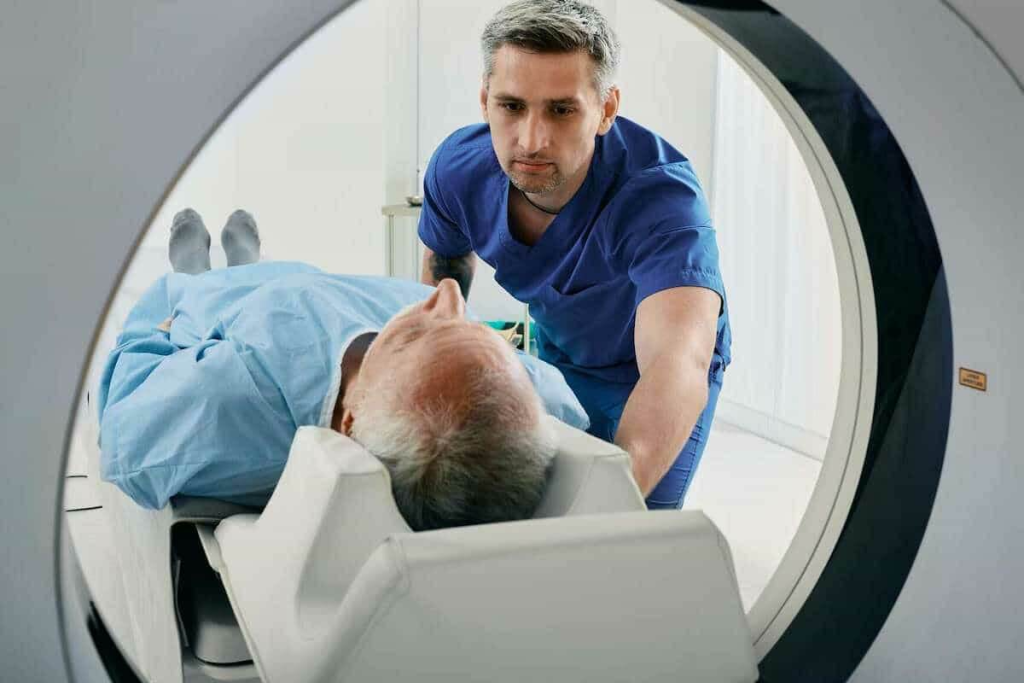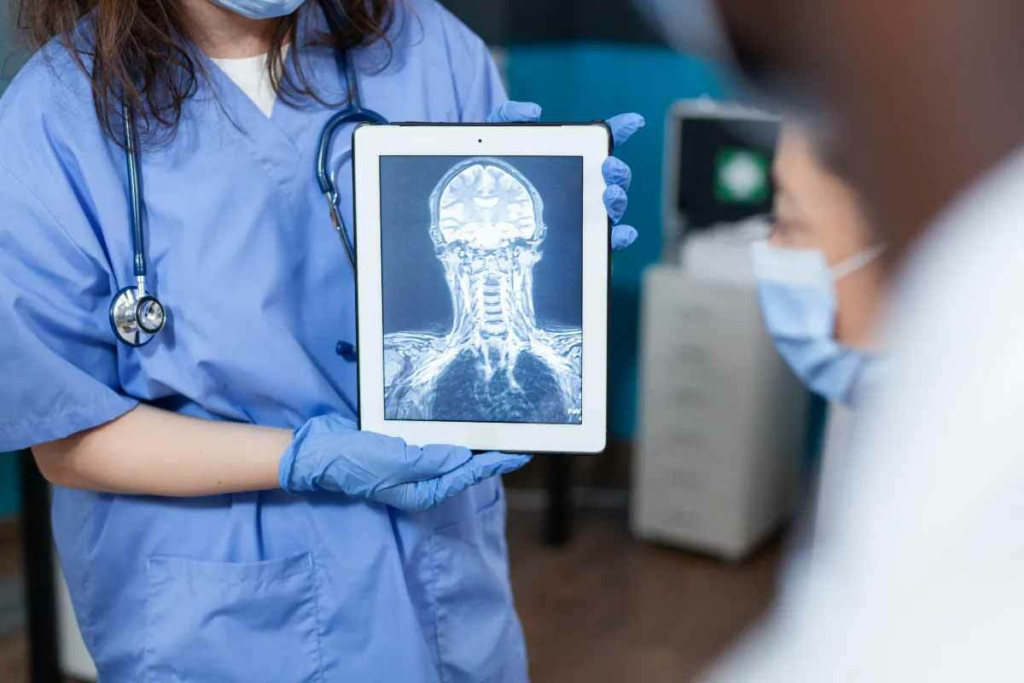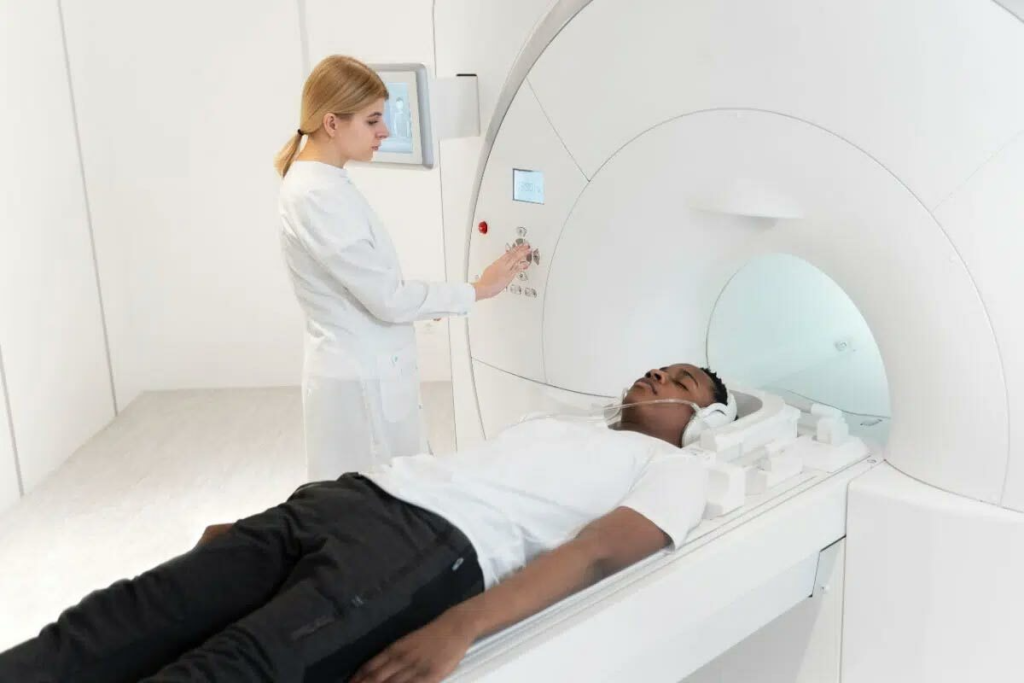
Choosing between a CT scan and an MRI is an important step for your health. At Liv Hospital, we always put patients first. Understanding what does a CT scan show that an MRI cannot helps you make more informed choices about your diagnostic tests.
CT scans are excellent for detecting bone fractures, lung conditions, and internal bleeding, often providing quicker results in emergency settings. Meanwhile, MRI excels at capturing detailed images of soft tissues, the brain, nerves, and certain tumors. The right test depends on your specific health condition and the level of detail needed. Knowing the unique strengths of CT and MRI allows you and your doctor to select the best option for accurate diagnosis and better treatment planning.

CT scans and MRI are key in today’s medicine. They help us see inside the body in different ways. These tools are vital for finding many health problems.
CT scans use X-rays to make detailed pictures of the body. A CT scanner, shaped like a doughnut, moves around the patient. It checks how much X-ray each body part absorbs.
Then, a computer turns this data into images. The key benefits of CT scans are:
MRI uses a strong magnetic field and radio waves to create images. It doesn’t use harmful radiation like CT scans do. Instead, it uses nuclear magnetic resonance to make detailed pictures.
The advantages of MRI are:
For more on MRI and CT scans, check out https://www.healthimages.com/mri-vs-ct-scan/.
CT scans and MRI work in different ways. CT scans use X-rays, while MRI uses magnetic fields and radio waves. This affects what they can show and how they’re used.
Key differences include:
Knowing these differences helps pick the right tool for each health issue. This leads to better diagnoses and treatments.

Understanding what CT scans can do is key in medical imaging. They are great in some situations, giving info MRI scans can’t.
CT scans are top-notch for bone fractures and skeletal abnormalities. They show bone details clearly. This makes them perfect for spotting complex fractures and bone spurs.
A study in the Journal of Orthopaedic Trauma found CT scans better than MRI for some fractures. This is true for the spine and pelvis.
“CT scans are the best for checking bones and finding calcifications,” says a radiologist.
For acute trauma, CT scans are the first choice. They’re fast and spot internal bleeding well. They quickly check injuries to organs, which is key in emergencies.
CT scans are great for lung and chest imaging. They find many conditions, like pneumonia and lung nodules, with high accuracy. This helps doctors diagnose and track lung diseases well.
A study in the American Journal of Respiratory and Critical Care Medicine showed CT scans beat MRI for lung issues. This is true for COPD patients.
CT scans are also good at finding calcifications and kidney stones. MRI can miss these, but CT scans spot them easily. This is key for diagnosing kidney stones and some gallbladder diseases.
“The sensitivity of CT scans in detecting kidney stones is unmatched, making them the preferred choice for diagnosing renal colic,” A urologist.
MRI technology has changed how we diagnose diseases. It gives us detailed views of soft tissues. This makes it key for spotting conditions that CT scans can’t find.
MRI is great at showing soft tissues like organs and tendons. It can tell soft tissues apart. This is vital for finding ligament sprains, tendonitis, and some musculoskeletal injuries.
An MRI can show how badly ligaments and tendons are damaged. This helps doctors decide the best treatment and prevent more harm.
MRI is the top choice for looking at the brain and spinal cord. It’s very good at finding lesions and other problems. It can spot multiple sclerosis plaques, tumors, and other issues that CT scans miss.
MRI gives clear images of ligament and tendon injuries. These are common in sports. It lets doctors see how bad the injury is.
This helps them plan the best treatment. It might mean avoiding surgery.
MRI is great for finding tumors in the brain and spinal cord. It can tell different types of tumors apart. It also shows how they affect nearby tissues.
This is key for planning treatment.
In short, MRI has big advantages over CT scans. It’s better at showing soft tissues, finding brain and spinal cord problems, and spotting ligament and tendon injuries. Its detailed images make it a must-have in today’s medicine.
It’s important to know how much diagnostic imaging costs. This includes comparing CT scans and MRI prices. These costs can affect healthcare budgets and what patients choose.
In the U.S., a CT scan usually costs about $1,200. An MRI is more expensive, around $2,000. Prices can change based on where you go, the location, and the technology used.
Cost Comparison Table
| Imaging Modality | Average Cost |
| CT Scan | $1,200 |
| MRI | $2,000 |
Insurance is key in figuring out what you’ll pay for CT scans or MRI. Most plans cover both, but how much can differ.
Patients should review their insurance to see what’s covered. Some plans might need you to get approval first or have certain rules.
Several things can change how much CT scans and MRI cost, including:
Knowing these factors and insurance details can help patients deal with the costs of CT scans and MRI.
Choosing between CT scans and MRI depends on time and how easy they are to get. Both have their own good points and bad points. These include how long the scan takes, if they’re available when you need them, and how comfortable they are for patients.
One big difference is how long each scan takes. CT scans are generally quicker, finishing in just a few minutes. On the other hand, MRI procedures are longer, taking between 20 and 40 minutes. This big difference affects how fast patients can be seen and how smoothly things run in hospitals.
| Imaging Modality | Typical Scan Duration |
| CT Scan | A few minutes |
| MRI | 20-40 minutes |
In emergencies, how fast and available imaging is matters a lot. CT scans are often preferred in trauma cases because they’re quick and give important info fast. MRI is great for some diagnoses but might not be as practical in urgent situations because it takes longer and has other setup needs.
Comfort is key when comparing CT scans and MRI. CT scans are faster, which might be better for some patients. But MRI, though longer, might be more comfy for those needing detailed soft tissue images without radiation. Yet, MRI machines can make some patients feel uneasy or anxious because of their enclosed design.
In summary, CT scans and MRI have their own advantages when it comes to time and ease of access. CT scans are quicker and more available in emergencies. MRI, though longer, offers detailed images without radiation but might cause some discomfort.
It’s important to know the risks and limits of CT scans and MRI. Both have their good points and bad points. We need to think about these carefully to keep patients safe and get the best results.
CT scans use radiation, which can increase cancer risk, mainly in young people. The dose from a CT scan is much higher than a regular X-ray. The American College of Radiology says the risk of cancer from a CT scan is small but real.
“The estimated lifetime risk of developing a fatal cancer from a CT scan is about 1 in 2,000.”
Also, CT scans sometimes use contrast agents. These can cause allergic reactions or harm the kidneys in some people.
Key risks associated with CT scans include:
MRI doesn’t use radiation, making it safer in this way. But, MRI has its own risks. These are mainly because of the strong magnetic field and radiofrequency energy. People with certain metal implants, like pacemakers, might not be able to have an MRI because of the risk of these devices moving or not working right.
Notable contraindications for MRI include:
When choosing between CT scans and MRI, we must think about different groups of patients. Pregnant women should avoid CT scans because of the radiation risk to the baby. Patients with severe kidney disease might need to avoid certain contrast agents used in both CT scans and MRI. Children are more sensitive to radiation, so MRI is often a better choice when it’s possible.
Special considerations include:
| Patient Population | Considerations |
| Pregnant Women | Avoid CT scans due to radiation risk; consider MRI for certain conditions |
| Children | Prefer MRI over CT when possible due to radiation sensitivity |
| Patients with Kidney Disease | Monitor kidney function before administering contrast agents |
Healthcare providers need to weigh these factors carefully. This helps them choose the best imaging method for each patient. It’s all about finding the right balance between getting the needed information and keeping the patient safe and comfortable.
Choosing between CT scans and MRI is key in medical imaging. Each has its own strengths and weaknesses. The right choice depends on the situation, like emergencies, brain issues, muscle problems, or cancer.
CT scans are best in emergencies because they’re quick. They help spot injuries fast. They’re great for finding bleeding, fractures, and internal damage.
In head trauma, CT scans quickly find hemorrhages or skull fractures. This helps doctors act fast.
MRI is better for brain and spinal cord issues. It shows soft tissues clearly. MRI finds conditions like multiple sclerosis, stroke, and spinal cord injuries better than CT scans.
Its detailed images are vital for diagnosing and tracking neurological problems.
MRI is top for muscle and bone issues. It shows soft tissues like ligaments and tendons well. MRI is great for spotting sprains, tendonitis, and meniscal tears.
This makes MRI essential for checking muscle and bone injuries.
CT scans and MRI are both key in cancer care. The choice depends on the cancer type and where it is. CT scans are used for lung, liver, and other organ tumors, and for cancer spread.
MRI is better for brain, spine, and soft tissue tumors. Both are used together to help decide treatment.
| Clinical Scenario | Preferred Imaging Modality | Key Benefits |
| Emergency and Trauma | CT Scan | Rapid assessment, detection of acute bleeding and fractures |
| Neurological Conditions | MRI | Superior soft tissue contrast, detailed lesion visualization |
| Musculoskeletal Disorders | MRI | Detailed imaging of soft tissues, diagnosis of ligament and tendon injuries |
| Cancer Diagnosis and Monitoring | Both CT and MRI | Complementary information for tumor detection and assessment |
Advanced imaging technologies are changing healthcare. Modern facilities lead this change. They use new protocols and equipment to improve care and patient results.
New imaging tech, like high-field MRI machines and advanced CT scanners, gives detailed views of health issues. For example, Liv Hospital uses state-of-the-art imaging modalities. This helps doctors diagnose and treat better. Key improvements include:
These updates help in making accurate diagnoses and treatment plans. A recent article highlights the importance of knowing the strengths of CT scans and MRI for better care (What’s the Difference Between a CT Scan and MRI).
Diagnostic imaging needs a team effort. Radiologists, clinicians, and others work together. This teamwork ensures patients get care that fits their needs.
The benefits of teamwork include:
Modern healthcare focuses on patient experience and quality. A good experience is key for patient happiness and health. Facilities like Liv Hospital use advanced tech and teamwork to set high care standards.
Important aspects of patient experience include:
By focusing on these, healthcare facilities can improve care quality for patients.
Knowing the differences between CT scans and MRI is key for correct diagnosis and treatment plans. A ct scan vs mri summary shows each has its own strengths. CT scans are great for seeing bone fractures, finding internal bleeding, and checking lung and chest issues. They are very useful in emergency cases.
MRI, on the other hand, is better for soft tissues. It’s the top choice for finding soft tissue problems, brain and spinal cord issues, and injuries to ligaments and tendons. When deciding between mri vs ct scan, the right choice depends on the patient’s situation and what doctors need to know.
In short, ct vs mri comparisons show the need to pick the right imaging method for each patient. By knowing what each technology can do, doctors can make better choices. This leads to better care for patients.
The choice between mri vs ct is more than just technology. It’s about picking the best tool for the job. This ensures patients get the most accurate diagnosis and the best treatment plan.
CT scans are great for finding bone fractures, acute trauma, and lung issues. They also spot calcifications and kidney stones well.
MRI is better for soft tissues, like the brain and spinal cord. It’s also good for ligament and tendon injuries. This makes it perfect for nervous system and musculoskeletal disorders.
CT scans are usually cheaper than MRI. In the U.S., CT scans cost less on average. But, prices can change based on location, insurance, and the procedure itself.
CT scans are faster and easier to get in emergencies. MRI takes longer and might be harder to find.
Yes, CT scans use radiation. MRI has metal implant issues. MRI can make people with claustrophobia uncomfortable. Some need contrast agents.
Doctors pick based on the situation. For emergencies, trauma, neurological, musculoskeletal, or cancer, they choose wisely. Each has its own strengths.
Modern facilities use new protocols and equipment. This improves image quality and accuracy. They focus on patient experience and quality care.
Yes, sometimes both are used together. This combines their strengths for a full diagnosis, helping guide treatment.
Subscribe to our e-newsletter to stay informed about the latest innovations in the world of health and exclusive offers!
WhatsApp us